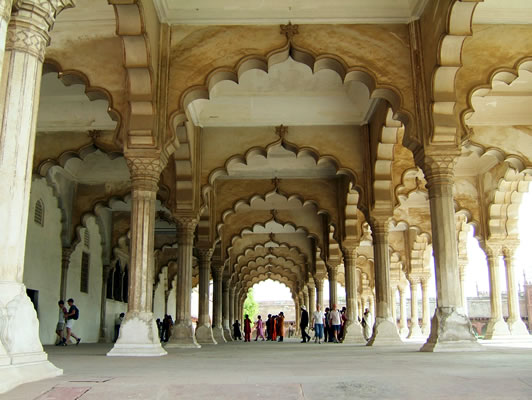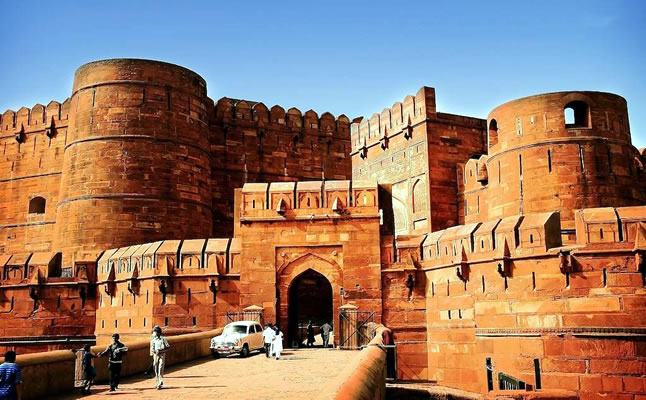Akbar’s Tomb, Sikandra
(1605-12 A.D.)
Hindi Version | View Gallery |
|
[Not a valid template]This is the Tomb of Jalaluddin Muhammad Akbar, son of Humayun and grandson of Babar, who was the greatest king of the Mughal Dynasty. He ruled from 1556 to 1605. He founded a vast empire which extended from Kabul to Assam and from Kashmir to Ahmednagar. His state functioned on the sound principle of peaceful co-existence with his non-believing subjects and was based on such secular institutions as the Mansabdari. He united the country under a uniform cultural, political and administrative system. He planted his kingship, in the Indian soil and made it an indigenous thing, thus earning the honorific epithet ‘Chakravartin’. He made a nation out of a mob, which is why he is styled: ‘Akbar The Great’. He was also a great builder and raised a series of forts throughout the empire. He founded Fatehpur Sikri, and built its beautiful palaces in the composite style. He re-built Agra Fort and raised numerous palatial mansions in it. He also planned his own Tomb and selected a site for it, near the Jamuna river, at Sikandara which was renamed ‘Bahishtabad’ (The Heavenly Abode). He died in 1605 when its construction had just begun. It was completed by his son Jahangir in 1612, on the original design of Akbar. [Not a valid template]The Tomb is planned in the centre of a vast garden enclosed by high walls on all sides, with a monumental, building in the middle of each one; that on the south side being the gateway. The garden is divided into four equal quarters, on the char-bagh plan, each quarter separated by a high terrace or causeway of stone masonry of 75 feet width with a small water channel running in its centre and raised walk-ways on the sides. They are distinctly raised from the garden, from which they are approached by staircases with cascades and lily-ponds. There are no cypress avenues or flower beds rising above the channels on the causeways. Thus, though the Tomb structure has been presented in a beautiful garden-setting, it has a character full of dignity, sobriety, thoughtfulness and quietitude, rather than of delicacy, gaiety or splendour, in accordance with the personality of Akbar, it has been designed to be an elegy, rather than a lyric. The gateway on the south side is two-storeyed. It has an iwan portal, 61 feet in height, each on its north and south sides, flanked by double alcoves. The whole exterior has been gorgeously finished in mosaic and inlay of colour stones in various designs. The most important feature of this gateway is the set of four circular, tapering minars of white marble which rise from the corners of its roof. Where normally chhatris would have been placed. Each minar is in three storeys separated by balconies and is crowned by a chhatri. This novel feature seems to have been inspired by the minarets of the Charminar of Hyderabad, built by Muhammad Quli Qutb Shah, C. 1591. [Not a valid template]This gate has persian inscriptions, carved in relief, on the south and north iwans and inside the hall. The south one is a long panegyric in praise of Jehangir. It mentions ‘Abdul Haq Shirazi’, the Calligrapher, and the date 1021 A.H. (1612 A.D.) of its completion. Twelve persian couplets are inscribed in ornamental cartouches inside the hall. They eulogise Akbar. The inscription on the northern iwan is also eulogical and praises Akbar and his tomb. It also reflects his philosophical views. Two couplets inscribed above the northern entrance doorway introduce the tomb as a whole, this gateway is a full monument and can stand independently anywhere else. [Not a valid template]The main Tomb has a unique design. It is square in plan and is in five receding storeys. The ground floor has spacious dalans, with an iwan portal in the middle on each side. Each portal is surmounted by an oblong 8 pillared chhaparkhat of white marble. The south portal has a vestibule leading into the grave chamber. It has quranic verses in stucco and painting. An octagonal tower, superimposed by an eight pillared chhatri, is attached to each corner of this storey which is, technically, just a plinth of the tomb which rests on it in four receding storeys. The lower three are composed of arched dalans supported on pillars, and chhatris attached to them. The topmost storey, built entirely of white marble has an open square court, 70 feet side, surrounded by 9 feet wide arched dalans on the four sides. A cenotaph is placed on the platform in the court. All exernal arches are closed by jalipanels. A beautiful panegyric, in 36 persian couplets, in praise of Akbar, is carved on the arches facing the court. They boldly ‘Nscribe Akbar’s philosophical views. There is no dome or barahdari, and the superstructure is vacant. In fact, it marks the beginning of a distinct class of domeless tombs of the mughal period. Though it is built of red sandstone. Jahangir has used white marble on the gate minarets, iwan-chhaparkhats and the topmost storey. One of the finest masterpieces of the great mughals, this tomb is a befitting monument to the memory of a great king of the status of Akbar. It was severally damaged in 18th century and the Archaeological Survey of India restored it between 1902 and 1911. |




